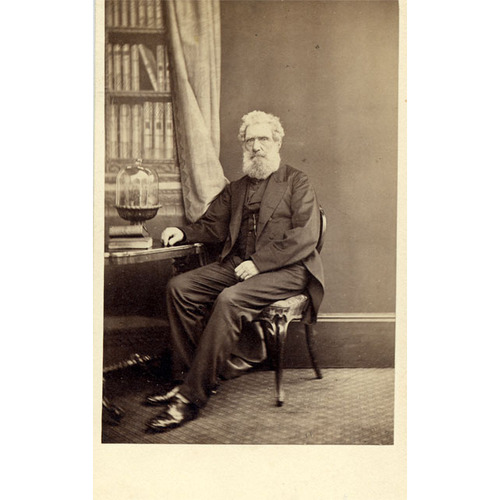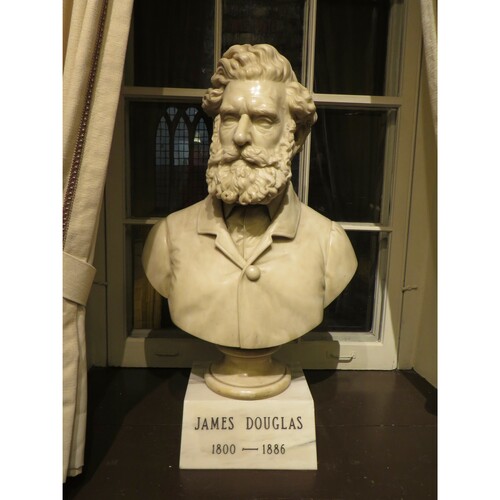![James Douglas, Universal Photographic Company [Vers 1875] Original title: James Douglas, Universal Photographic Company [Vers 1875]](/bioimages/w600.12602.jpg)
Source: Link
DOUGLAS, JAMES, doctor; b. 20 May 1800 at Brechin (Tayside), Scotland, son of George Douglas, a Methodist minister, and Mary Mellis; d. 14 April 1886 in New York City.
After serving a five-year apprenticeship under Dr Thomas Law of Penrith, England, James Douglas went in 1818 to study surgery in Edinburgh where there were highly renowned surgeons and medical schools. In March 1819, he enlisted as surgeon on a whaler and went to Spitsbergen, but resumed his studies in August and obtained his diploma as a surgeon from the Royal College of Surgeons in Edinburgh in April 1820. During his training he had diligently taken the anatomy classes of dynamic young Robert Liston, as well as those of John Barclay, whose lively style of teaching Douglas appreciated. In May, having attended lectures in London by John Abernethy and Sir Astley Paston Cooper, he received a diploma from the Royal College of Surgeons of that city. He spent a year in India, and upon his return in the autumn of 1822 accepted a position as director of medical services in a settlement on the Mosquito Coast in Honduras. But by the following autumn, seriously ill with the yellow fever he had picked up in that unhealthy climate, he had to go to Boston, Mass., for treatment. On his recovery, he thought of going back to Scotland, but not before paying a visit to John Stephenson* and Andrew Fernando Holmes*, former colleagues who lived in Montreal. On the way, he was forced to stop unexpectedly at Utica, N.Y., because of repairs to the Erie Canal. He decided to settle in Utica where in 1824 he married Hannah Williams. He also brought his young brother, George Mellis Douglas*, over from Scotland to serve as his assistant and begin medical training. For two years he lectured in anatomy and surgery at the medical college in Auburn; he also received an honorary doctorate in medicine from the Berkshire Medical Institution of Williams College in New York State.
After two bold experiments in dissection on corpses he had managed to obtain clandestinely, Douglas had to flee in midwinter 1825–26 to avoid the legal consequences. In Montreal his friends Stephenson and Holmes, who were aware of his surgical skill, strongly advised him to stay in Canada and establish himself in Quebec City. Arriving there on 13 March 1826, he quickly acquired a large clientele, being successful, it seems, in correcting strabismus and club-foot. He also won the esteem of Quebec’s foremost doctors, including Joseph Morrin* and Joseph Painchaud*. The latter offered Douglas a room in his house on Rue de l’Arsenal, to use for dissection at his convenience. For many years the mortal remains of convicted criminals were taken there after execution. Douglas nearly died of typhus in the winter of 1828–29 but resumed work after a long convalescence. In September 1830 his wife died of tuberculosis; the couple’s two children had died in infancy. A year later, he married Elizabeth, daughter of Archibald Ferguson, of Quebec City.
In 1832 during a serious cholera epidemic in Quebec City construction had begun on the naval hospital; two years later, when cholera had again broken out, this became the Marine and Emigrant Hospital. After the doctor in charge, William Augustin Hall, died in 1837, Douglas agreed to take his post provided he could have an experienced doctor such as Painchaud to work with him. The hospital, which had been mismanaged, was in a sorry state. Douglas was strict, authoritarian, methodical, and self-disciplined, and demanded the same qualities in his subordinates. Under his direction this 300-bed hospital, dedicated to the care of sick sailors and immigrants, quickly became famous, and the training given gained wide recognition. Positions there were sought by medical students who, in order to obtain a licence to practise in that period, had to demonstrate the level of their knowledge before a committee appointed by the governor. A student was sure to make a favourable impression if he had worked under Douglas, Painchaud, and their team. When Joseph Morrin opened his Quebec Medical School in 1848, the Marine and Emigrant Hospital became the centre for clinical teaching.
At the turn of the 19th century, the care of the mentally deranged in Lower Canada was deplorable. They were scattered throughout hospitals and prisons in Quebec City, Montreal, and Trois-Rivières where they were shut up in “cells” like prisoners. In 1824 a commission set up under John Richardson* to investigate their situation had recommended a complete revision of the system. Nothing had been done to implement this report prior to 1843 when the new governor, Sir Charles Theophilus Metcalfe*, strongly urged the Legislative Assembly to recommend that a special organization be established to undertake the care of the mentally ill. Two years later Metcalfe asked Douglas to assume responsibility for the insane in the province under the existing contract system (a system by which the government paid a specific sum for each patient in the hospitals and the latter remained private institutions). Douglas accepted and served for three years. In partnership with doctors Joseph Morrin and Charles-Jacques Frémont*, he bought Robert Giffard* de Moncel’s manor-house at Beauport and had it converted for his new patients. On 5 Sept. 1845 the Asile de Beauport (Centre hospitalier Robert-Giffard) was opened, and Metcalfe then took steps to ensure that the 81 insane persons rotting in the prison of Montreal and in the hospitals at Trois-Rivières and Quebec were transferred to it. Many of them had not seen the sun for years and they rediscovered themselves, living together and working on the farm or doing domestic chores. This therapy produced excellent results, many of the patients becoming well enough to return to their families.
Douglas had taken his role seriously, devoting himself to his patients, but in so doing had neglected the Marine and Emigrant Hospital where the situation had deteriorated; it became necessary for a royal inquiry to be instituted in 1852. The inquiry was directed by doctors Wolfred Nelson* and Robert Lea MacDonnell* and by Zéphirin Perrault, a lawyer from Kamouraska, Canada East. Dr Anthony von Iffland* was its secretary. It left no doubt as to Douglas’ professional competence but his tyrannical behaviour was censured. After this he gradually gave up the practice of medicine but he renewed his contract at the Beauport asylum.
Douglas had suffered from respiratory disorders since 1850, and had spent winters in Egypt, Italy, and Palestine, from which he brought back numerous souvenirs, in particular several mummies now housed in the museum of Université Laval and the Metropolitan Museum of Art in New York. With the deaths of Dr Morrin in 1861 and Dr Frémont in 1862, Dr Jean-Étienne Landry, through the purchase of some of their shares, became co-owner of the asylum at Beauport. When Douglas left for Europe in 1865, he authorized his son to liquidate his share, and it was bought by Joseph-Édouard Cauchon on behalf of Dr François-Elzéar Roy. Douglas’ fortune was vanishing. He had speculated in mining properties that had proved worthless, and he was even obliged to auction off his property at Beauport.
In 1875 he went to Phoenixville, Penn., to live with his son James, the sole remaining member of his immediate family. Two of the four sons of his second marriage had died in infancy, and another, George, had died in 1861, just after obtaining a commission in the British army; his wife had died in 1859. Douglas spent the last 11 years of his life in the United States. On 10 April 1886 he had a cerebro-vascular stroke and died four days later. He was buried in Mount Hermon Cemetery, at Sillery, Que., which he himself had helped to establish.
James Douglas was the author of “Account of the attempt to form a settlement on the Mosquito shore in 1823,” Literary and Hist. Soc. of Quebec, Trans., new ser., 6 (1869): 25–39; Journals and reminiscences, ed. James Douglas Jr (New York, 1910); and “A whaling voyage to Spitzbergen in 1818,” Literary and Hist. Soc. of Quebec, Trans., new ser., 10 (1873): 21–67. Correspondence is in the possession of Mrs. F. N. Douglas (Lakefield, Ont.).
ANQ-Q, État civil, Anglicans, Cathedral of the Holy Trinity (Quebec), 1 Oct. 1830; Presbytériens, St John’s Church (Quebec), 19 Oct. 1831. R. B. Douglas, “Biographical sketches of James Douglas, M.D., 1800–1886, and James Douglas, LL.D., 1837–1918” (speech delivered at an unveiling ceremony at the Pavillon Perry of Douglas Hospital, Verdun, Que., 1971). H. H. Langton, James Douglas: a memoir (Toronto, 1940). Sylvio Leblond, “Anatomistes et résurrectionnistes en Grande-Bretagne,” Canadian Medical Assoc., Journal (Toronto), 93 (1965): 73–78, 113–20; “Le docteur George Douglas (1804–1864),” Cahiers des Dix, 34 (1969): 145–64; “L’hôpital de la Marine de Québec,” L’Union médicale du Canada (Montréal), 80 (1951): 616–26; “James Douglas M.D. (1800–1886),” Canadian Medical Assoc., Journal, 66 (1952): 283–87; “Joseph Painchaud,” L’Union médicale du Canada, 82 (1953): 182–87; “Québec en 1832,” Laval médical (Québec), 38 (1967): 183–91; “William Marsden (1807–1885), essai biographique,” Laval médical, 41 (1970): 639–59. C.-A. Martin, “Le premier demi-siècle de la psychiatrie à Québec,” Laval médical, 12 (1947): 710–38. C. K. Russel, “Dr. James Douglas, 1800–1886, adventurer: famous as a physician, surgeon and alienist – a leader among men,” American Neurological Assoc., Trans. ([New York]), 61 (1935): 2–6.
Cite This Article
Sylvio Leblond, “DOUGLAS, JAMES (1800-86),” in Dictionary of Canadian Biography, vol. 11, University of Toronto/Université Laval, 2003–, accessed April 27, 2025, https://www.biographi.ca/en/bio/douglas_james_1800_86_11E.html.
The citation above shows the format for footnotes and endnotes according to the Chicago manual of style (16th edition). Information to be used in other citation formats:
| Permalink: | https://www.biographi.ca/en/bio/douglas_james_1800_86_11E.html |
| Author of Article: | Sylvio Leblond |
| Title of Article: | DOUGLAS, JAMES (1800-86) |
| Publication Name: | Dictionary of Canadian Biography, vol. 11 |
| Publisher: | University of Toronto/Université Laval |
| Year of revision: | 1982 |
| Access Date: | April 27, 2025 |




